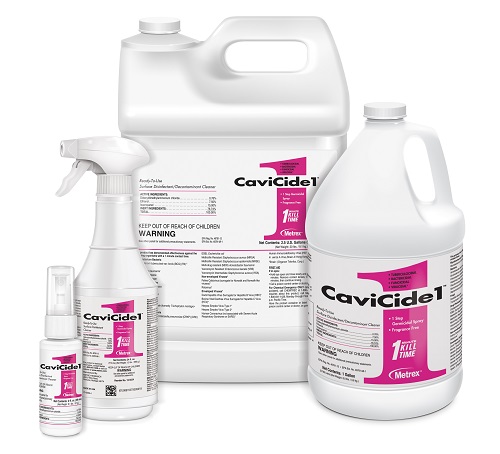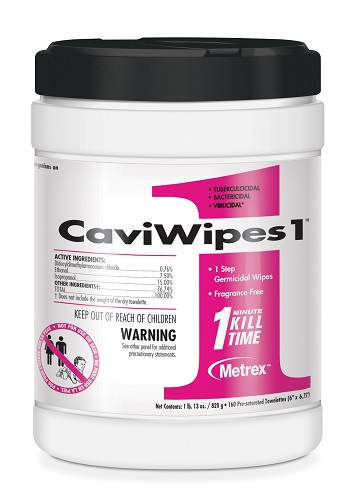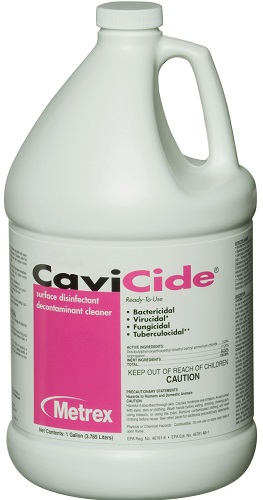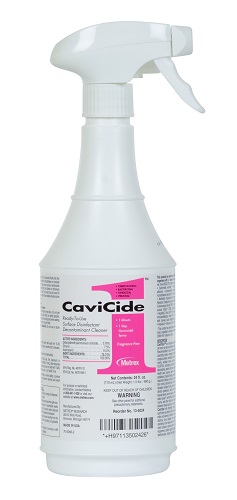 Loading... Please wait...
Loading... Please wait...Free Shipping on orders over $400
Categories
CaviCide Surface Disinfectant Cleaner for Preventing Infection and Cross Contamination on Medical Surfaces
Posted on 01/15/2019 10:16:45

Every year, approximately 75,000 people across the United States die from healthcare-associated infections (HAI). At any moment, nearly one in 20 patients contracts an infection while being treated in hospitals and other health care facilities. In fact, these infections can account for as much as $33 billion in medical costs across the nation every year.
The use of CaviCide and CaviCide1, reliable and effective surface disinfectant cleaners manufactured by Metrex Research Laboratories, is a key front-line defense for the myriad pathogens that can circulate through your facility, your medical team, and your patients.
CaviCide cleaner has been shown to effectively kill the following pathogens within two to three minutes of contact:
14 Bacteria and Viruses CaviCide Helps Prevent
1. Methicillin-Resistant Staphylococcus aureus
2. Staphylococcus aureus with reduced susceptibility to vancomycin
3. Staphylococcus aureus
4. Vancomycin-Resistant Enterococcus faecalis
5. Pseudomonas aeruginosa
6. Salmonella enterica
7. Trichophyton mentagrophytes
8. Mycobacterium tuberculosis var. bovis, which causes tuberculosis
9. Herpes Simplex virus types 1 and 2
10. Human Coronavirus (not associated with Severe Acute Respiratory Syndrome)
11. Human Immunodeficiency Virus
12. Hepatitis B virus – HBV
13. Hepatitis C virus – HCV
14. Influenza A2 virus
A wide range of pathogens, including bacteria, viruses, and fungi, can be eliminated by regularly using CaviCide disinfectant cleaner to thoroughly disinfect your surgical space and other key areas of your health care facility where the sharing of pathogens can be of concern.
Whether you're stocking medical supplies for a hospital, surgery center, urgent care center, nursing home, dental practice, veterinary practice, or other, keeping surfaces clean and minimizing the risk of cross-contamination is a key concern for every health care facility. CaviCide, along with other high-level disinfectants, helps the medical staff maintain a clean environment reducing the chances for cross contamination. This allows the medical team to focus on the important work they do, providing the best possible care for patients.
CaviCide disinfectant is effective against everything from norovirus to A. baumannii and many others; in fact, some formulations of CaviCide have been shown to kill norovirus within 30 seconds. The immediacy of CaviCide's disinfectant efficacy is an important facet; without quick and immediate disinfection, many pathogens can persist for days or even months, continuing to be transmitted across your health care facility and potentially to your patients.
CaviCide versus CaviCide1
CaviCide is the original formula developed and produced by Metrex Research. CaviCide is effective against 15 organisms and has kill times from 2-3 minutes depending on the organism. CaviCide1 is the latest multi-purpose disinfectant/decontaminant cleaner from Metrex Research. CaviCide1 is a multi-purpose cleaner and disinfectant with a 1-minute contact time for virucidal, bactericidal (including TB), and fungicidal activity. CaviCide1 is fragrance-free and bleach-free. CaviCide and CaviCide1 are available in commonly used sizes. CaviCide1 is slightly more expensive.

Summary Comparision Table*: CaviCide1 versus CaviCide
| CaviCide1 | Time | CaviCide | Time |
| Acinetobacter baumannii | 1 min. | ||
| Bovine Viral Diarrhea Virus Surrogate for Hepatitis C Virus (HCV) | 1 min. | Hepatitis C Virus (HCV) | 2 mins. |
| Burkholderia cepacia | 1 min. | ||
| Candida albicans | 1 min. | ||
| Carbapenem-Resistant Klebsiella pneumonia [(CRKP)] ][CRE] | 1 min. | ||
| Duck Hepatitis Virus Surrogate for Hepatitis B Virus (HBV) | 1 min. | Hepatitis B Virus (HBV) | 2 mins. |
| Enterobacter cloacae | 1 min. | ||
| ESBL Escherichia coli [ESBL E. coli] | 1 min. | ||
| Feline Calicivirus | 1 min. | ||
| Herpes Simplex Virus Type 1 | 1 min. | Herpes Simplex Virus Type 1 | 2 mins. |
| Herpes Simplex Virus Type 2 | 1 min. | Herpes Simplex Virus Type 2 | 2 mins. |
| Human Coronavirus | 1 min. | Human Coronavirus** | 2 mins. |
| Human Immunodeficiency Virus (HIV-1) | 1 min. | Human Immunodeficiency Virus (HIV-1) | 2 mins. |
| Influenza A Virus | 1 min. | Influenza A2 Virus | 2 mins. |
| Klebsiella pneumoniae | 1 min. | ||
| Methicillin Resistant Staphylococcus aureus (MRSA) | 1 min. | Methicillin Resistant Staphylococcus aureus (MRSA) | 3 mins. |
| Methicillin Resistant Staphylococcus epidermidis (MRSE) | 1 min. | ||
| Multi-drug resistant [MDR] Acinetobacter baumannii | 1 min. | ||
| Mycobacterium tuberculosis var: bovis (BCG) (TB) | 1 min. | Mycobacterium tuberculosis var: bovis (BCG) (TB) | 3 mins. |
| Pseudomonas aeruginosa | 1 min. | Pseudomonas aeruginosa | 3 mins. |
| Rotavirus | 1 min. | ||
| Salmonella enterica | 1 min. | Salmonella enterica | 3 mins. |
| Staphylococcus aureus | 1 min. | Staphylococcus aureus | 3 mins. |
| Staphylococcus aureus with reduced susceptibility to vancomycin | 3 mins. | ||
| Trichophyton mentagrophytes | 1 min. | Trichophyton mentagrophytes | 3 mins. |
| Vancomycin Intermediate Staphylococcus aureus (VISA) | 1 min. | ||
| Vancomycin Resistant Enterococcus faecalis (VRE) | 1 min. | Vancomycin Resistant Enterococcus faecalis (VRE) | 3 mins. |
*Summary comparison contact Metrex Research for product details.
**Not associated with Severe Acute Respiratory Syndrome or SARS.
CaviWipes and CaviWipes1
Both CaviCide and CaviCide1 are available in convenient, ready to use towelettes. CaviWipes and CaviWipes1 are durable, nonwoven, non-abrasive wipes pre-saturated with CaviCide and CaviCide1. CaviWipes and CaviWipes1 are available in a range of sizes.
CaviWipes are available in the following sizes and quantities.
- 6” x 6.75” Canister: 160 wipes per canister, 12 canisters per case
- 6” x 6.75” Canister: 220 wipes per canister, 12 canisters per case
- 9” x 12” CaviWipesXL Canister: 65 wipes per canister, 12 canisters per case
- 9” x 12” CaviWipesXL Box: 50 wipes per box, 6 boxes per case
- 7” x 9” Flat Pack: 45 wipes per pack, 20 packs per case

CaviWipes1 are available in the following sizes and quantities.
- 6” x 6.75” Canister: 160 wipes per canister, 12 canisters per case
- 9” x 12” Canister: 65 wipes per canister, 12 canisters per case
- 9” x 12” Singles in a Box: 50 wipes per box, 6 boxes per case
- 7” x 9” in a Flat Pack: 45 wipes per pack, 20 packs per case

Because of their convenience and effectiveness CaviWipes and CaviWipes1 are widely used in medical facilities all over the world.
Why Use CaviCide
Though many pathogens encountered within the medical space can have dramatic and negative results for your patients, the good news is that the proper use of medical disinfectants can halt them in their tracks. CaviCide is powerful, ready-to-use and convenient – and it can be used in a variety of areas including operating rooms, surgical centers, laboratories, isolation rooms, individual patient rooms, and even neonatal intensive infant care units.
Convenience
With CaviCide, you get a decontaminant, cleaner and disinfectant all rolled into one, which saves your team time and offers them tremendous convenience. The product is highly effective when used according to instructions. Studies show that it can thoroughly clean and decontaminate the critical surfaces and instrumentation your team needs. In addition, CaviCide is available in multiple formats to best meet your team's needs. You can choose CaviCide Spray, CaviCide Wipes (called CaviWipes), or CaviCide AF. In addition, some CaviCide disinfectant formulations are alcohol-free and bleach-free, so you can use them on surfaces that might be sensitive to those substances. The 24-oz spray bottle is a particularly popular choice, and it's also available in 8-oz, one-gallon, and 2.5-gallon options.

Protection
CaviCide and CaviCide1 can help you ensure the safety and cleanliness of your "circle of care" – defined by Metrex Research as touchpoints that comprise the most critical within a health care facility for preventing infections. Typical circle of care components include areas like operating rooms, waiting rooms, patient rooms, isolation rooms, endoscopy equipment, your facility's sterile processing department, mobile equipment, and even hallways. Using CaviCide can help prevent cross-contamination in your entire facility as your team and your patients move throughout these areas.
Versatility
CaviCide and CaviCide1 surface disinfectants can be used to clean a variety of surgical and medical tools and equipment, including Mayo stands , oxygen hoods, amalgamators and dental curing lights, interior and exterior surfaces of infant incubators, ambulance equipment surfaces, and exterior surfaces of respiratory therapy equipment and anesthesia machines. This type of reusable equipment has been known to be responsible for harboring bacteria or viruses and thus spreading HAIs.
CaviCide and CaviCide1 cleaner are safe to use on most medical devices, regardless of their materials, and is also tremendously effective for hard, nonporous surfaces throughout your health care practice. Its versatility and benefits make it uniquely suited for success within many different health care settings.
No matter the type of health care facility you stock, your medical center can benefit from making sure you have CaviCide as part of your standard supplies. Hospitals, surgical centers, emergency medical facilities, laboratories, nursing homes, dental offices, ophthalmic and optometric facilities, veterinary care facilities, and more, rely on regular disinfection and appropriate pathogen control.

How to Use CaviCide
Surface disinfection with CaviCide is quite simple. First, spray the product directly onto the surface you need to clean, and then wipe with a clean paper towel in order to rid the area of bioburdens and other debris. Make sure to immediately discard the used paper towel. According to the CaviCide instructions, then spray CaviCide onto the newly cleaned surface, making sure the area is thoroughly wet before following CaviCide label instructions for the appropriate contact time you need.
Wipe clean with a new paper towel, which you should immediately discard. The disinfection process is now complete. In case of skin contact, wash your hands immediately after using – for further disinfection that is easy on your team's skin, use an antiseptic soap like Hibiclens.
Safety and Storage Precautions
As with any chemical agent, your team will need to familiarize yourselves with the CaviCide Material Data Safety Sheet, or MSDS. When not used safely, there are some dangers your team could inadvertently face. You'll want to abide by a few basic guidelines when it comes to storing and using CaviCide. First, make sure to avoid contaminating food items or water through your storage protocol. It is a flammable liquid and can cause eye irritation when used inappropriately. In general, the most acute health risks associated with using CaviCide include irritation of the eyes, nose or throat, along with drowsiness and dizziness.
Storage
According to the CaviCide Material Safety Data Sheet, you'll need to store the disinfectant well away from open flames, hot surfaces, heat or sparks, and no one should smoke near the product. Store in a cool, well-ventilated area and keep the container tightly closed. Room temperature is typically a sufficient storage temperature. Do not reuse empty containers, as they house product residue and may be hazardous. Electrical lighting and ventilation equipment will need to be rated as explosion-proof, and you should take all appropriate preventative measures to avoid static discharge. In case of fire, use water spray or fog, dry chemical, alcohol-resistant foam, or carbon dioxide to extinguish the flames.
Use
When using the product, avoid breathing in the vapors and make sure to wash your hands thoroughly after each use. As a safety precaution, wash your hands again before eating, drinking, or chewing gum. You may also want to use gloves or even eye protection as an extra precautionary measure to avoid CaviCide side effects. You could also use respiratory protection as a precautionary measure, but it usually isn't necessary as long as you have adequate ventilation. In general, it's a good idea to keep the CaviCide and CaviCide1 safety data sheet posted where team members can refer to it with ease.
Safety and First Aid
In situations that may result in prolonged exposure to hands, impervious gloves such as those made from butyl rubber may be most appropriate for your team. Avoid getting CaviCide surface disinfectant cleaner on your clothing. Contaminated clothing should be removed and washed as soon as possible before wearing again. If CaviCide is inhaled, move the victim into fresh air as soon as possible and have him or her rest in a position that helps promote deep breathing. Alert a physician if this doesn't help alleviate symptoms. If someone experiences eye contact with CaviCide, make sure they gently rinse for several minutes and remove contact lenses if possible. If eye irritation doesn't clear up, the person should seek medical attention. Additionally, you should reach out to Poison Control or an emergency medical facility if CaviCide is ingested.
Disposal
When it comes to disposing of CaviCide disinfectant containers or unused quantities, you'll need to do so in accordance with federal, state and local regulations. In general, you can take the following approach for unused quantities: Dilute with water and dispose of via your ordinary sanitary sewer system.
For container disposal, be sure to triple-rinse the empty container. If you can, send it for recycling or reconditioning, or puncture and dispose of in a sanitary landfill. If recycling your empty container is not an option, make sure to comply with your health care facility's policies and protocols, along with those of your local community.
CaviCide and CaviCide1 Save Lives and Lower Costs
Bacteria and viruses that cause everything from tuberculosis to hepatitis and AIDS are constantly around us and can be transmitted anywhere health care services are delivered. Infection from these pathogens can be dramatically reduced or even avoided completely if your team follows the Centers for Disease Control guidelines, along with the proper protocol for sterilizing and disinfecting patient-care equipment.
Many evidence-based studies of infection prevention highlight the importance of appropriate and effective disinfection and decontamination of all surfaces and reusable medical tools and devices within your health care facility. By using a physical or chemical agent like CaviCide and CaviCide1 disinfectant cleaner to kill all pathogens on your health care facility's environmental surfaces and patient care areas, you can disrupt the cycle of transmitting those pathogens and reduce your overall incidence of HAIs.
If you're still researching your options and would like some help, the team at USA Medical and Surgical Supplies has decades of experience researching and recommending medical supplies and equipment. Please contact us if you have any questions about the best ways to clean and disinfect your health care facility. Our goal is to provide top quality medical supplies and equipment at low prices. We leverage technology and streamline our operations to provide the best value for our customers. E-mail us on our Contact form, or call toll-free: 1-866-561-2380.



